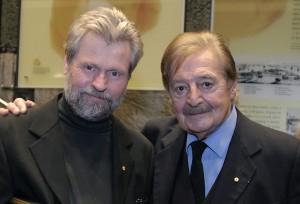© Ross Edwards 2015
Peter Sculthorpe (1929–2014)
On 8 August 2014 my dear friend and former teacher, the eminent Australian composer Peter Sculthorpe, passed away in Sydney after a long illness. I first met Peter as a student, when he joined the Music Faculty of Sydney University. That was 51 years ago. I used to work for him during vacations as copyist, phone and letter answerer, coffee maker etc. – an infinitely more rewarding holiday job than sorting mail!
Peter treated his students as apprentices. His house was like a workshop where an open, friendly atmosphere prevailed. He would often talk to us about whatever he was working on and invite us to participate in the compositional process, taking our ideas seriously and making us feel important. Genial and encouraging, he nonetheless demanded the highest standards. In those days, long before computers were used, music was composed with pencil and paper; the final score and parts copied by hand in ink, with much recourse to correction fluid. I often worked well into the early hours of the morning, especially if a deadline was imminent. As he’d finish composing a page, Peter would hand it to me for copying, inspecting it afterwards to make sure it was neat and accurate. Sometimes I’d have it returned with comments like “fix spacing”, or “straighten stems”. In this way I learnt to understand and accept professional standards.
In the 1960s and 70s, Peter scornfully renounced Australia’s insidious artistic inferiority complex known as “the cultural cringe” by pioneering a breakaway from dependence on Europe and beginning to explore the music of our Asian neighbours. These were exciting times. He became fascinated by Japanese gagaku, as well as Indonesian gamelan music, before either became well-known here. Their influence can be heard in such landmark works as Mangrove (1979) and Sun Music III (1967). A film was made about a visit he made to Bali and he also spent time in Japan as a cultural ambassador. Gradually his attention began to shift to the Australian landscape, especially that of the outback. One of his best-known landscape works is Kakadu (1988), with its earth-based drones and ecstatic flights of birds. Melodic lines resembling the contours of Aboriginal chant also began to weave their way through the textures of his music at this time, culminating in his monumental, all-embracing Requiem (2004).
Peter has been an inspiration to generations of composers. The name Peter (from the Greek Petros) means “rock”, symbolising stability, and so many composers have found him both stabilising and inspiring throughout an uncertain climate for the arts, especially for so-called “classical” music. Some years ago I was asked to write an article about Peter’s lifestyle, which I summed up as follows: “As a Taurean, his house has always been his castle, his studio, and the hub of all his activities. It perfectly reflects his personality, especially his need for order and symmetry. Everything must be in its right place before he can work. He is surrounded by things that are especially significant to him – books, screens, paintings, musical instruments etc. Most are constants, having acquired iconic status over the years, although some are periodically recycled to accord with his current interests or mood.” To this I would add that he eschewed any form of exercise, refused to take holidays, and that over the years my family and I found him kind, patient, generous, supportive, scintillating, wicked and at times outrageous: the full gamut. A wonderful composer and human being.
Ross Edwards
Ross Edwards with Peter Sculthorpe at the 2005 APRA/AMCOS Awards


